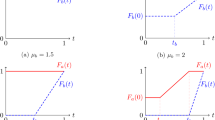Abstract
We provide Game-theoretic analysis of the arrival process to a multi-server system with a limited queue buffer, which admits customers only during a finite time interval. A customer who arrives at a full system is blocked and does not receive service. Customers can choose their arrival times with the goal of minimizing their probability of being blocked. We characterise the unique symmetric Nash equilibrium arrival distribution and present a method for computing it. This distribution is comprised of an atom at time zero, an interval with no arrivals (a gap), and a continuous distribution until the closing time. We further present a fluid approximation for the equilibrium behaviour when the population is large, where the fluid solution also admits an atom at zero, no gap, and a uniform distribution throughout the arrival interval. In doing so, we provide an approximation model for the equilibrium behaviour that does not require a numerical solution for a set of differential equations, as is required in the discrete case. For the corresponding problem of social optimization, we provide explicit analysis of some special cases and numerical analysis of the general model. An upper bound is established for the price of anarchy (PoA). The PoA is shown to be not monotone with respect to population size.






Similar content being viewed by others
Notes
This is the solution to the equilibrium condition (4), presented in the previous section.
For a discussion on how such a common belief can emerge see [9].
Although two customers try at T, only customer 2 is admitted if there is only one vacant waiting spot, and hence \(\ell _2(\underline{t}^*)<\ell _3(\underline{t}^*)\).
We have not been able to find an example where the overall objective function is not convex.
References
Altman, E., Gaujal, B., Hordijk, A.: Multimodularity, convexity, and optimization properties. Math. Oper. Res. 25(2), 324–347 (2000)
Feller, W.: An Introduction to Probability Theory and Its Applications, vol. 2. Wiley, New York (1968)
Glazer, A., Hassin, R.: \({?}/{M}/{1}\): on the equilibrium distribution of customer arrivals. Eur. J. Oper. Res. 13(2), 146–150 (1983)
Glazer, A., Hassin, R.: Equilibrium arrivals in queues with bulk service at scheduled times. Transp. Sci. 21(4), 273–278 (1987)
Hassin, R., Haviv, M.: To Queue or Not to Queue: Equilibrium Behavior in Queueing Systems, vol. 59. Springer, Boston (2003)
Hassin, R., Kleiner, Y.: Equilibrium and optimal arrival patterns to a server with opening and closing times. IIE Trans. 43(3), 164–175 (2011)
Hassin, R., Mendel, S.: Scheduling arrivals to queues: a single-server model with no-shows. Manag. Sci. 54(3), 565–572 (2008)
Haviv, M.: When to arrive at a queue with tardiness costs? Perform. Eval. 70(6), 387–399 (2013)
Haviv, M., Milchtaich, I.: Auctions with a random number of identical bidders. Econ. Lett. 114(2), 143–146 (2012)
Honnappa, H., Jain, R.: Strategic arrivals into queueing networks: the network concert queueing game. Oper. Res. 63(1), 247–259 (2015)
Honnappa, H., Jain, R., Ward, A.R.: A queueing model with independent arrivals, and its fluid and diffusion limits. Queueing Syst. 80, 1–33 (2014)
Jain, R., Juneja, S., Shimkin, N.: The concert queueing game: to wait or to be late. Discrete. Event Dyn. Syst. 21(1), 103–138 (2011)
Juneja, S., Raheja, T.: The concert queueing game: fluid regime with random order service. Int. Game Theory Rev. 17(02), 1540012 (2015)
Juneja, S., Shimkin, N.: The concert queueing game: strategic arrivals with waiting and tardiness costs. Queueing Syst. 74(4), 369–402 (2013)
Kaandorp, G.C., Koole, G.: Optimal outpatient appointment scheduling. Health Care Manag. Sci. 10, 217–229 (2007)
Lin, K.Y., Ross, S.M.: Optimal admission control for a single-server loss queue. J. Appl. Probab. 41(2), 535–546 (2004)
Mazalov, V.V., Chuiko, J.V.: Nash equilibrium in the optimal arrival time problem. Comput. Technol. 11, 60–71 (2006)
Otsubo, H., Rapoport, A.: Vickreys model of traffic congestion discretized. Transp. Res. B Methodol. 42(10), 873–889 (2008)
Pegden, C.D., Rosenshine, M.: Scheduling arrivals to queues. Comput. Oper. Res. 17(4), 343–348 (1990)
Ravner, L.: Equilibrium arrival times to a queue with order penalties. Eur. J. Oper. Res. 239(2), 456–468 (2014)
Ravner, L., Haviv, M.: Equilibrium and socially optimal arrivals to a single server loss system. In: International Conference on NETwork Games Control and Optimization: NetGCoop’14. Trento, Italy, October (2014)
Stein, W.E., Côté, M.J.: Scheduling arrivals to a queue. Comput. Oper. Res. 21(6), 607–614 (1994)
Vickrey, W.S.: Congestion theory and transport investment. Am. Econ. Rev. 59(2), 251–260 (1969)
Acknowledgments
The authors thank Yoav Kerner for his advice on simplifying some of the proofs in this paper, and two anonymous reviewers for their helpful comments. The authors gratefully acknowledge the financial support of Israel Science Foundation Grant No. 1319/11.
Author information
Authors and Affiliations
Corresponding author
Rights and permissions
About this article
Cite this article
Haviv, M., Ravner, L. Strategic timing of arrivals to a finite queue multi-server loss system. Queueing Syst 81, 71–96 (2015). https://doi.org/10.1007/s11134-015-9453-y
Received:
Revised:
Published:
Issue Date:
DOI: https://doi.org/10.1007/s11134-015-9453-y




